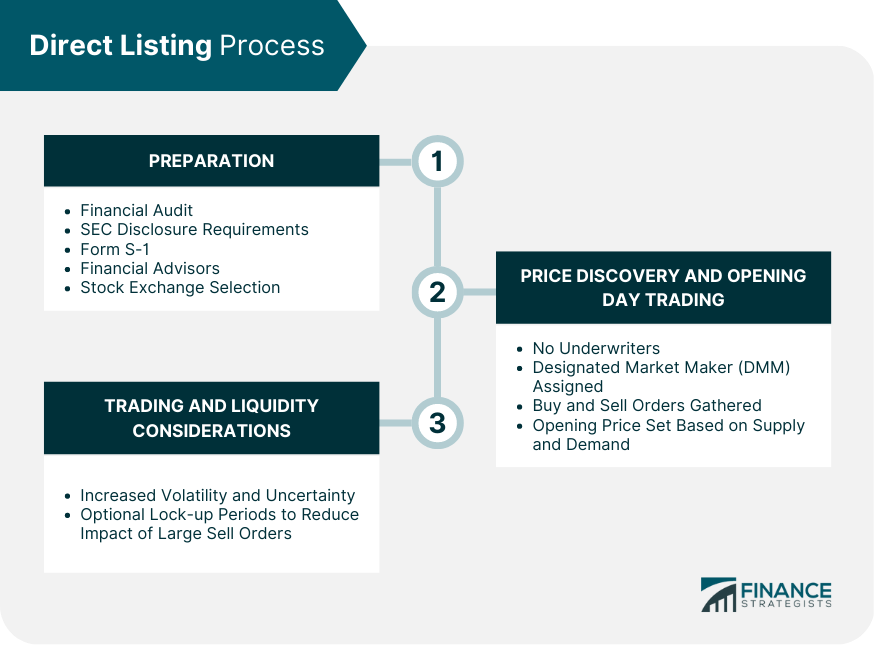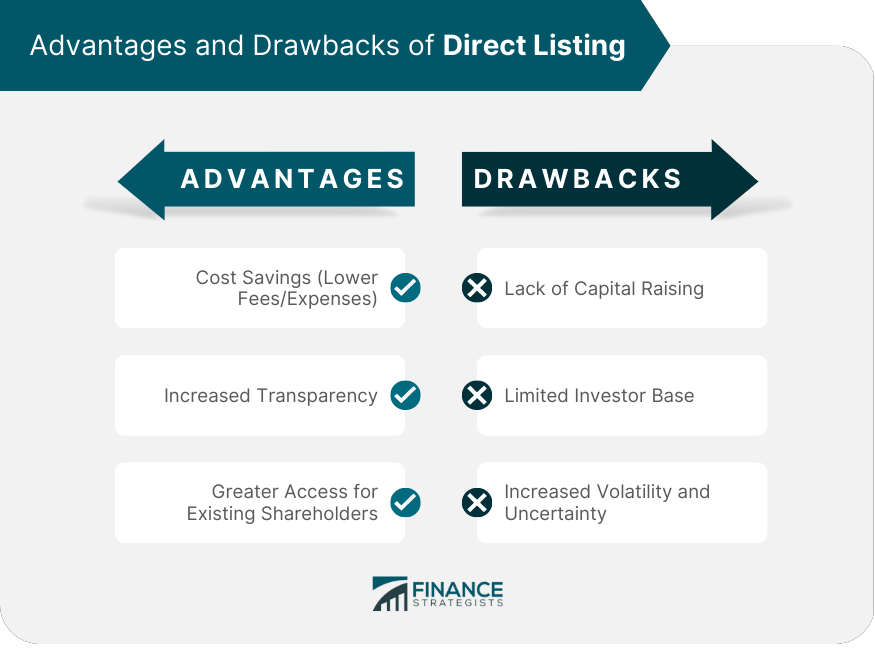Direct Listing is a process by which a company lists its shares directly on a stock exchange without the involvement of underwriters or investment banks. Unlike traditional initial public offerings (IPOs), in which companies issue new shares and sell them to the public, direct listings allow existing shareholders to sell their shares directly to the public. Direct listings provide a way for companies to go public without the cost and regulatory requirements associated with an IPO. Companies that opt for direct listings can save on underwriting fees and avoid diluting existing shareholders' ownership. Direct listings can also provide a more transparent and efficient way for companies to go public, as the market sets the share price based on supply and demand. However, direct listings can also be riskier than IPOs, as there is no price stabilization or lock-up period for existing shareholders. While direct listings have gained popularity in recent years, the concept is not new. Early instances of direct listing can be traced back to the 20th century, when smaller companies used this method to access public markets without the costs and complexities associated with traditional IPOs. Over the years, regulatory bodies such as the Securities and Exchange Commission (SEC) have introduced new rules and guidelines to streamline the direct listing process, making it more attractive and accessible to a wider range of companies. These changes have also led to an increase in the number of high-profile direct listings, which has helped to raise awareness and acceptance of this alternative method of going public. Before pursuing a direct listing, companies must undergo a financial audit and meet the disclosure requirements set forth by the SEC. This includes preparing a registration statement, Form S-1, which contains detailed information about the company's business, financial condition, and management team. Companies also need to select financial advisors and a stock exchange on which to list their shares. Unlike traditional IPOs, direct listings do not involve underwriters who set an initial offering price. Instead, the stock exchange assigns a Designated Market Maker (DMM) to facilitate price discovery during the opening auction. The DMM gathers to buy and sell orders from various market participants and determines an opening price that balances supply and demand. The absence of underwriters and institutional investors in a direct listing can lead to increased volatility and uncertainty in the early days of trading. While lock-up periods for insiders are not mandatory in direct listings, companies may choose to implement them to reduce the potential impact of large sell orders on the stock price. One of the main benefits of the direct listing is the potential for cost savings. Companies can avoid the significant fees and expenses associated with underwriters, enabling them to allocate more resources to other aspects of their business. Direct listings promote transparency by allowing the market to determine the stock price based on supply and demand. This process can help avoid the potential underpricing that may occur in traditional IPOs, where underwriters set the initial offering price. Direct listings provides existing shareholders with immediate access to liquidity, as there is no dilution of ownership and no lock-up period for insiders by default. This feature is particularly attractive to employees and early investors who may want to sell their shares without restrictions. In a direct listing, companies do not issue new shares or raise additional capital. For businesses seeking to fund growth initiatives, a direct listing may not be the most suitable option. Direct listings can result in a limited investor base, as there are no guaranteed institutional investors, and attracting retail investors can be challenging. The lack of underwriters and institutional investors in direct listings can lead to increased volatility and uncertainty during the initial trading period. This can result in unpredictable stock price movements and potential challenges in establishing a stable market for the shares. When deciding between a direct listing and a traditional IPO, companies should consider their capital needs, growth strategy, company size, market reputation, and investor relations objectives. For example, businesses that require substantial capital to fund growth initiatives may find a traditional IPO more suitable, while companies with a strong financial position and established reputation may prefer the cost savings and transparency of a direct listing. In some cases, companies may explore hybrid approaches to going public, such as a direct listing with a capital raise or a merger with a Special Purpose Acquisition Company (SPAC). These alternative methods can offer unique benefits and address some of the limitations of direct listings or traditional IPOs. Direct listings have become a popular alternative to traditional IPOs, offering cost savings, transparency, and greater access for existing shareholders. However, there are drawbacks to consider, such as the lack of capital raising and limited investor base, which can result in increased volatility and uncertainty during the initial trading period. When deciding between a direct listing and a traditional IPO, companies should carefully evaluate their capital needs, growth strategy, market reputation, and investor relations objectives. Hybrid approaches, such as direct listings with a capital raise or SPAC mergers, can also provide unique benefits and address some of the limitations of both direct listings and traditional IPOs. Ultimately, the choice between a direct listing and a traditional IPO depends on a company's specific circumstances and goals.Definition of Direct Listing
History and Development of Direct Listing
Early Instances of Direct Listing
Evolution of Regulations and Practices
Direct Listing Process
Preparation for Direct Listing
Price Discovery and Opening Day Trading
Trading and Liquidity Considerations

Advantages of Direct Listing
Cost Savings
Increased Transparency
Greater Access for Existing Shareholders
Drawbacks of Direct Listing
Lack of Capital Raising
Limited Investor Base
Increased Volatility and Uncertainty

Choosing Between Direct Listing and Traditional IPO
Factors to Consider
Hybrid Approaches
Conclusion
Direct Listing FAQs
Direct listings and traditional IPOs are both methods for a company to go public, but there are key differences. In direct listings, companies do not issue new shares or raise capital, and there is no involvement of underwriters. Direct listings allow market-driven price discovery and provide immediate liquidity for existing shareholders. Traditional IPOs, on the other hand, involve underwriters who set an initial offering price and help raise capital by issuing new shares.
Companies may choose direct listings over traditional IPOs for several reasons, including cost savings, increased transparency, and greater access for existing shareholders. Direct listings can lower fees and expenses associated with underwriters, provide a market-driven price discovery process, and offer immediate liquidity for existing shareholders without diluting their ownership.
In direct listings, price discovery is facilitated by a designated market maker (DMM) during the opening auction on the stock exchange. The DMM gathers buy and sell orders from various market participants and determines an opening price that balances supply and demand, allowing the market to set the stock price based on true market conditions.
The potential drawbacks of direct listings include the lack of capital raising, a limited investor base, and increased volatility and uncertainty during the initial trading period. Companies do not issue new shares or raise additional capital in direct listings, which can be a limitation for businesses seeking funding for growth. Additionally, attracting institutional and retail investors can be challenging, and the absence of underwriters may lead to increased stock price volatility.
Traditionally, direct listings do not involve issuing new shares or raising capital. However, some companies have explored hybrid approaches, such as direct listings with a capital raise, to address this limitation. These alternative methods can offer unique benefits and enable companies to access public markets while still raising the necessary funds for their growth initiatives.
True Tamplin is a published author, public speaker, CEO of UpDigital, and founder of Finance Strategists.
True is a Certified Educator in Personal Finance (CEPF®), author of The Handy Financial Ratios Guide, a member of the Society for Advancing Business Editing and Writing, contributes to his financial education site, Finance Strategists, and has spoken to various financial communities such as the CFA Institute, as well as university students like his Alma mater, Biola University, where he received a bachelor of science in business and data analytics.
To learn more about True, visit his personal website or view his author profiles on Amazon, Nasdaq and Forbes.











